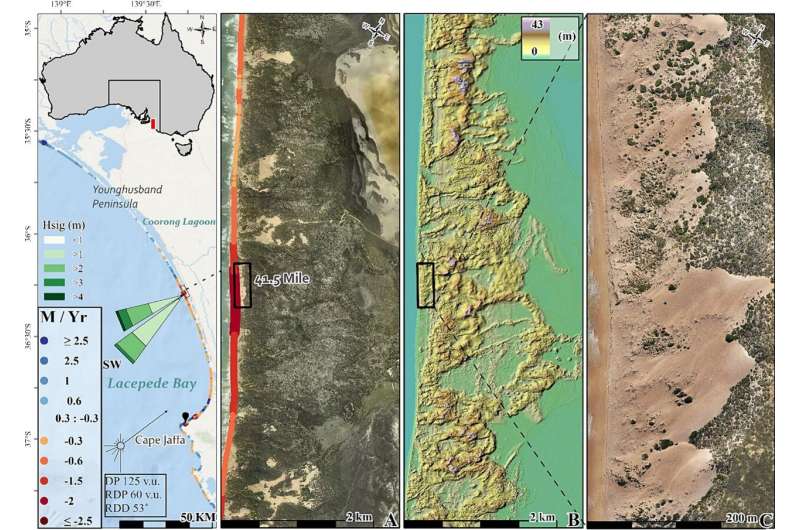This article has been reviewed according to Science X's editorial process and policies. Editors have highlighted the following attributes while ensuring the content's credibility:
fact-checked
peer-reviewed publication
trusted source
proofread
South Australian coastal dunes are on the march

Coastal transgressive dunefields are on the march in South Australia—retreating inland from an angry ocean at an alarming rate. Yet while this occurs in plain sight, communities are largely oblivious to long-term coastal changes, and Flinders University's Professor Patrick Hesp, strategic professor of coastal studies at Flinders University's College of Science and Engineering, is concerned this is all happening in a geological blink of the eye.
Measurements taken by Flinders University's Beaches and Dunes Systems (BEADS) Laboratory of the Younghusband Peninsula—Australia's longest coastal dunefield, stretching 190km from the Murray River mouth to Kingston South East—have identified accelerated dune movement due to coastal erosion, triggering rapid evolution of a new dune phase.
The research, "Coastal Transgressive Dunefield Evolution as a Response to Multi-decadal Shoreline Erosion", has been published by the Geomorphology journal.
"This is an extraordinary rate of development and, if the shoreline erosion trend continues to expand north and south as it appears to be doing, it will dramatically change the National Park dune system—and may also significantly impact the Coorong Lagoon as dune sands invade it," says Professor Hesp.
The central region of the Younghusband Peninsula, near 42 Mile Crossing (63km northwest of Kingston SE), recently switched to a major shoreline erosion phase.
This coastal barrier was largely unvegetated in the 1940s but gradually changed to a more stabilized and vegetated system as rabbits and domestic animal grazing was removed. However, since 1980, this shoreline has eroded about 100 meters at an average rate of 1.9m per year.
A new dunefield developed in less than five years, and has extended landwards more than 100 meters in eight years.
These relatively large-scale dune systems are the coastal equivalent of continental sand seas—and they dominate the South Australian coast, but are also common on many coasts throughout the planet.
"We tend to think of most dune formation phases having developed over a long period of time, but our research has shown the opposite to be true on the Younghusband Peninsula," says Flinders researcher Dr. Marcio DaSilva, who wrote his Ph.D. on this subject.
"We are witnessing the evolutionary trajectory of that coastal sand sheet as it responds to sustained erosion and the dune sheet transitions to a dunefield."
While many hypotheses have been forwarded to explain why this has happened—such as climate change, increased windiness, fire, coastal erosion and tsunami—the few proven factors include sea level rise, particularly the Holocene transgression, a single massive storm, water table collapse and human actions often occurring during climate change.
Professor Hesp says the research findings are a call to action for increased research on coastal processes and particularly on the relationships between sea level rise, future climate change and the response of coastal dune systems.
"This study provides direct evidence that shoreline erosion and subsequent cannibalization of a formerly vegetated dunefield has produced a new transgressive dunefield at an extremely rapid rate and in less than a decade. It's the proof that there is cause for alarm."
More information: Marcio D. DaSilva et al, Coastal transgressive dunefield evolution as a response to multi-decadal shoreline erosion, Geomorphology (2024). DOI: 10.1016/j.geomorph.2024.109165
Journal information: Geomorphology
Provided by Flinders University




















